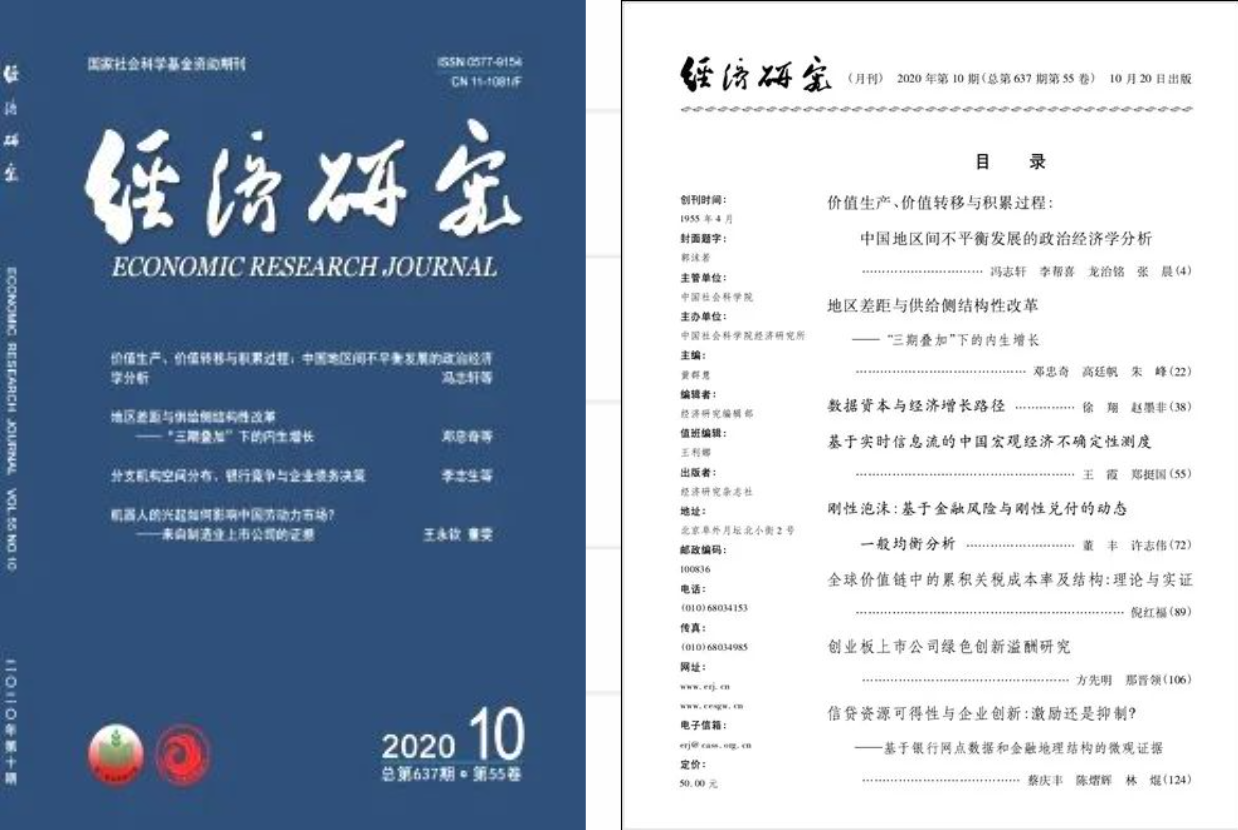岭南观点·08 基于实时信息流的中国宏观经济不确定性测度
我院王霞副教授与厦门大学郑挺国教授合作的论文《基于实时信息流的中国宏观经济不确定性测度》于2020年10月在经济学中文顶级期刊《经济研究》发表。

宏观经济不确定性作为一个重要的经济测度指标,反映了整个经济系统的不可预测程度。从经济理论而言,不确定性的增加使得消费者推迟消费行为、雇主减少雇佣人数、决策者在做出决策时也会更加谨慎。这不仅在微观层面上影响居民的资产配置和家庭决策、公司投资率和资产分配,而且在宏观层面上使得产出和消费显著下降、弱化宏观经济政策的调控效果。因此,研究经济状况的不确定性,对于优化家庭资产配置、理解宏观经济波动行为、制定合理的宏观调控政策以及提前预警经济金融运行风险等,有着重要的理论意义和实践价值。
尽管宏观经济不确定性对于经济运行有着重要的影响,但是该指标无法直接观测,因此,如何及时合理地测度经济不确定性是相关研究的一个关键问题。本文选取我国季度GDP同比增速和月度指标同比增速等与宏观经济态势直接相关的七个指标,运用混频动态因子模型计算不同指标在宏观经济测度中的贡献,并以此为权重,对预测误差加总,形成宏观经济意外指数和不确定指数。与现有文献相比,这种测度方法的主要优势在于:
第一,考虑了GDP在宏观经济监测中发挥的重要作用,通过混频建模方法,综合利用了与宏观经济态势直接相关的月度和季度数据,在数据信息上更加充分;
第二,以"日度"为频率,在新数据发布时实时更新不确定性测度结果,将最新的经济活动信息迅速地体现到宏观经济不确定性测度中,从而能够更及时有效地监测宏观经济不确定性的变动。这种实时分析的方法不仅考虑了数据修正的影响,而且允许不同指标发布时间存在差异,能够更加准确及时地刻画决策者在制定政策时获得的数据信息。
第三,充分考虑了不同指标在宏观经济监测中重要程度的差异,对不同指标赋予不同权重。该权重不仅由数据内生决定,避免了人为设定权重的任意性,而且随着数据发布信息的差异而发生变化,反映了数据信息的累积对权重的影响。
第四,本文构造的宏观经济不确定指数是历史预测误差的加权累积,而非单期预测误差的加总,避免了单期预测不稳定性对不确定指数的影响。
基于本文构造的宏观经济意外指数和不确定指数,本文进一步研究了其与货币政策、宏观经济波动之间的关系。研究结果表明,宏观经济不确定性冲击对利率存在负向影响;在经济波动较大时,经济衰退会导致宏观经济不确定性提高,而在经济平缓时期,宏观经济不确定性则是引起经济下滑的因素之一。
本文基于实时信息流构建的中国宏观经济不确定指数,能够以"日度"为单位,将最新的经济活动信息迅速地体现在宏观经济不确定性测度中,从而可以为宏观经济政策的制定以及企业发展战略的实施等提供更及时、可靠的经济预判。从宏观经济调控角度而言,央行可以基于最新数据实时更新对当前经济状况以及未来经济形势的判断,进而制定出更具有时效性、更合理的宏观调控政策;从企业微观决策角度而言,企业能够更加明晰的认识当前经济形势,从而调整投资方案和发展战略等。这无论是对于国家层面的宏观调控还是市场层面的微观决策都具有重要意义。
Measuring China's Macroeconomic Uncertainty Using Real Time Data Information
WANG Xia and ZHENG Tingguo
Abstract Since the great recession of 2008,many researchers have shown interest in understanding economic uncertainty and its effects on the macro-economy. Economic uncertainty reflects the unpredictability of an economic system and is of great theoretical and empirical value for optimizing the asset allocation of households, developing reasonable economic policies, and predicting economic and financial risk. As macroeconomic uncertainty is not directly observable, many scholars focus on ways to measure it. Studies have adopted the perspectives of financial market volatility, forecast error, and text data of news information, among others. However, existing indices have drawbacks for measuring China's macroeconomic uncertainty. First, the commonly used uncertainty indices represented by VIX and EPU cannot fully measure macroeconomic uncertainty, as they mix macroeconomic uncertainty with other kinds of uncertainty. Second, prior studies either construct a quarterly uncertainty index based on quarterly GDP directly or give up the quarterly GDP and construct a monthly uncertainty index to improve timeliness. Obviously, the quarterly uncertainty index cannot track the economic condition in a timely manner, and ignoring the GDP data will result in the loss of valuable information. Third, existing macroeconomic uncertainty indices update monthly or quarterly, and cannot reflect the economic condition in a timely manner. Finally, the related literature constructs the uncertainty indices based on final data and does not consider the data revision problem. The data also suffer from other problems, such as periodic missing, ragged-edge data. If we ignore these problems, then the final data used by scholars will be different from the real data used by policy-makers. In this paper, we follow Scotti(2016)to construct China's macroeconomic surprise index and uncertainty index. We choose seven economic variables:the year-on-year growth rates of quarterly GDP, quarterly urban disposable income, monthly industrial value-added, monthly investment in fixed assets, retail of social consumer goods, total imports and exports, and tax revenue. We evaluate the contributions of each economic variable on the economic condition using Zheng & Wang's(2013) year-on-year mixed frequency dynamic factor model. We then use it to calculate the weighted sum of the forecast error, and we further construct the surprise and uncertainty indices. Compared with the existing uncertainty index, our surprise and uncertainty indices have the following advantages. First, we consider the important role of GDP and extract common factors based on the mixed frequency dynamic factor model. Second, the index is daily, as it updates every time new information about the economic condition releases. We not only consider the data revision problem but also allow the various variables to release at different times. Third, we compute the weights representing the contribution of the economic indicators to the business condition. These weights are time-varying and depend on the time elapsed. Finally, the constructed uncertainty index is the weighted accumulation of historical forecast errors rather than single-period forecast errors. We apply the constructed indices to study the effects of economic uncertainty on the interest rate market and the business cycle. Specifically, our application to the business cycle shows that when the economy is highly volatile, the deterioration of the economic situation will increase macroeconomic uncertainty. When the economy is stable, macroeconomic uncertainty will affect the economic situation.The data on the macroeconomic surprise and uncertainty indices are daily. The indices update once new information becomes available due to the newly released data. These indices can therefore reflect the latest information on economic activities and enable timely and reliable evaluation of the economic situation, which is valuable for the determination of macroeconomic policies and the implementation of enterprises' development strategy. Timely measurement of economic uncertainty is of great significance for macro control at the national level and micro decision-making at the market level. With the collection of more real-time data and the development of the high-dimensional mixed-frequency dynamic factor model, we will be able to extend our project to big data by incorporating more economic variables.

王霞
中山大学岭南学院副教授,博士生导师。2013年毕业于厦门大学王亚南经济研究院,获得经济学博士学位。主要研究领域为非线性时间序列分析、宏观经济实时监测与即时预测等。迄今已在国际经济评论、计量经济学杂志、商业与经济统计学杂志、计量经济学理论、《经济研究》、《管理科学学报》等国内外经济管理类权威期刊发表学术论文20余篇。先后主持国家自然科学基金青年项目、国家自然科学基金面上项目以及教育部人文社科研究项目等各类课题。



